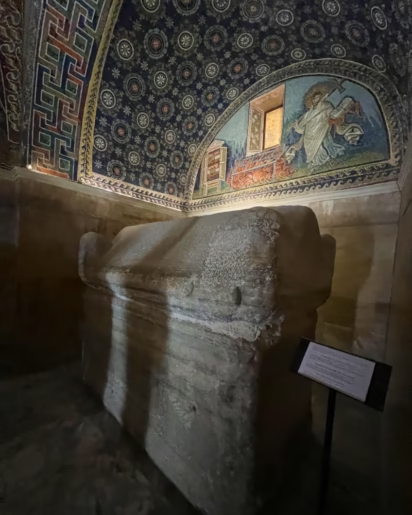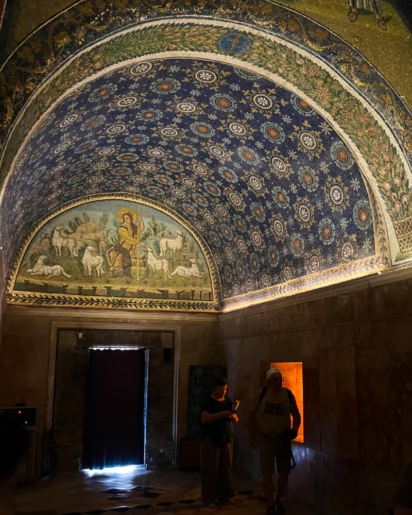The Mausoleum of Galla Placidia has the oldest Christian mosaics in Ravenna and is a top sight for day trippers and passengers on shore excursions from Venice.

Galla Placidia’s mausoleum behind the Basilica di San Vitale has the oldest and among the most impressive mosaics in Ravenna. The building itself is small and unassuming, but the interior is almost completely covered by mosaics from the early fifth century. Ravenna is famous for eight sites inscribed on the UNESCO World Cultural Heritage list as early Christian monuments with important Byzantine wall mosaics. The Mausoleo di Galla Placidia is one of the top sights and requires time-slot reservations. These are easiest to make when buying tickets online.
Ravenna is a very popular day-trip destination from larger cities such as Bologna, Rimini, and Venice. The town and mosaics are also very popular for shore excursions of cruise boats calling in Venice. Excursion group tours can easily fill up many slots, making it sensible to book time-slot reservations online well in advance of visiting
Galla Placidia in Ravenna, Italy

Galla Placidia (AD 392 – 450) was one of the talented women who occasionally leaped out of the history pages of late Roman and early medieval history. In a man’s world, she performed extraordinarily well.
Galla Placidia was of the nobility. She was the daughter of Emperor Theodosius I the Great – the last Emperor to have ruled the Western and Eastern Roman Empires simultaneously – the half-sister of Emperors Arcadius and Honorius, and mother of Emperor Valentinian III (for whom she acted as regent). She was also a captive of the Visigoths but later married their King Ataulf. After his murder – she was (perhaps surprisingly) not involved – she married the later Emperor Constantius III, who died in 421 after less than a year in office.

Numerous intrigues later, Galla Placidia found herself regent (425 – 437) of the Western Roman Empire for her underage son, who became Emperor Valentinian III. As regent, Galla Placidia engaged in numerous grandiose building projects in Rome, Jerusalem, and Ravenna. Today, she is mostly famous for her mausoleum, which has the oldest surviving mosaics in Ravenna.
At the end of Galla Placidia’s life, she had the misfortune of daughter trouble. This led to an episode of history more absurd than the cheapest soap opera plot. Her daughter Justa Grata Honoria refused to marry the family’s choice. In a moment of stupidity, Justa sent a letter and engagement ring to Attila the Hun, offering her hand in marriage and half of the Western Roman Empire as dowry. Justa Honoria was quickly married off to a Roman.

Galla Placidia had the good fortune of dying in November 450, a few months before the Huns started raiding Italy with Justa’s letter as an excuse (not that the Huns ever needed one). Attila would raid Italy repeatedly until his death in 453, claiming to fight for his honor and rights.
For the Byzantines, this was not too bad an episode. Justa’s letter diverted the Huns from their original destination – Constantinople.
Mausoleum of Galla Placidia in Ravenna

The Mausoleum of Galla Placidia is a smallish, unassuming brick building in the garden at the back of the Basilica di San Vitale in Ravenna. The Latin cruciform building (12.75 by 10.25 m, or 42 by 35 ft) is fairly unadorned, with even its brick dome hidden externally by a small square brick tower.
The mausoleum was erected during Galla Placidia’s rule in Ravenna, making it the oldest of the mosaic monuments in town. (It is roughly a century older than the adjacent San Vitale.)
Mosaics of the Mausoleum of Galla Placidia

The UNESCO documents describe the Mausoleum of Galla Placidia as the artistically most perfect of all the mosaics in Ravenna. It is the perfect blend of the Hellenistic-Roman artistic tradition with the iconography of Christianity.
Except for the lower parts of the wall clad in yellow marble, the rest of the walls and ceiling of the Mausoleum of Galla Placidia are completely covered in mosaics.
The northern lunette shows (a beardless) Christ the Shepherd surrounded by sheep. The southern lunette has St Lawrence with a gridiron – the symbol of his martyrdom. The upper walls of the central bay have mosaics of eight apostles.
However, the barrel vaults and the arches have in a sense the most impressive mosaics. The dark blue vault with white-golden stars is artistically of an extremely high quality. The patterns on the intrados are almost modern.
The interior of the mausoleum is softly lit with alabaster covering the 14 small window openings. The three sarcophagi are empty and of uncertain origin. It was long claimed – almost certainly erroneously – that they contained the remains of Galla Placidia, her son Valentinian III, and her second husband Constantius III.
Galla Placidia died in 450 in Rome and was almost certainly buried there. It is highly unlikely that her remains were ever interred in Ravenna. Some historians also question if the building was ever a mausoleum at all but rather an oratory or chapel for St Lawrence.
Visiting the Mausoleum of Galla Placidia
Time-slot reservations are essential to see the mausoleum — this is easiest online when buying a ticket.
Admission to the Mausoleum of Galla Placidia is controlled with a set number of visitors generally allowed to remain in the building for around five minutes at a time.
The exact procedure of the day depends a bit on the weather and the number of visitors. On a quiet day with fine weather, you are generally allowed to enter around your allotted time and remain inside as long as you please. A simple curtain covers the door — it is not a climate regulatory set of doors, as for example at The Last Supper in Milan or the Scrovegni Chapel in Padua, where turning up 30 seconds late prevents entry.
The mausoleum is in the far corner of the walled enclosure that also contains the Basilica San Vitale and the National Museum of Ravenna.
→ See Visiting the UNESCO-Listed Sites in Ravenna for more details on opening hours and admission tickets. At times, a small surcharge is payable to see the mausoleum — this is money well spent!
NEXT: Mausoleum of Theodoric
More Articles on Ravenna, Italy

Time-slot reservations are currently essential to see the Mausoleum of Galla Placida and the Neonian Baptistry in Ravenna. This is easiest done when buying the tickets online.
- Top Sights to See in Ravenna
- UNESCO-Listed Sites in Ravenna
- Visiting UNESCO-Listed Sites in Ravenna – Opening Hours and Tickets
- Neonian Baptistery & Archbishop’s Chapel
- Arian Baptistery
- Basilica of Sant’Apollinare Nuovo
- Basilica of San Vitale
- Mausoleum of Galla Placidia
- Mausoleum of Theodoric
- Basilica of Sant’Apollinare in Classe
- National Museum of Ravenna
Book Guided tours of Ravenna — tours are generally three hours. For tours not including admission fees, around €12 per person must be added. Small groups and families may find better value in private tours.

